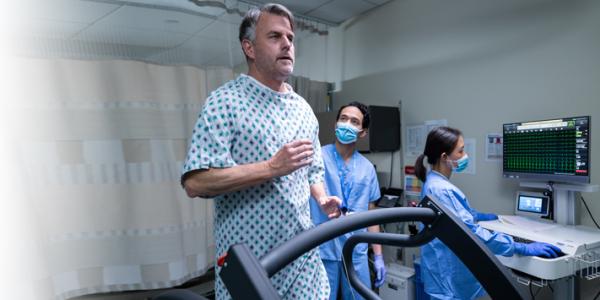
Technology helps regulate the heart's timing
Shaun Cho, MD
Shaun Cho, MD
An irregular heartbeat (arrhythmia) can be relatively harmless — or it could lead to serious complications, including stroke, cardiac arrest or heart failure. If you have an arrhythmia, you may not know it and feel fine. Or you may have symptoms such as a fluttering in the chest, chest pain, shortness of breath, sweating, dizziness and fainting.
If you've been diagnosed with a benign arrhythmia and have no symptoms, your doctor might advise doing nothing. However, if you're having symptoms, or if you have an arrhythmia that puts you at high risk for heart problems, you need to be evaluated by a cardiologist — and you're likely to hear the word "electrophysiology."
Electrophysiology may sound like a 21st century innovation, but its origins can be traced all the way back to the 18th century. An Italian physician named Luigi Galvani was dissecting a frog when he discovered what he called "animal electricity."
Now we know that all cells and tissues in our bodies have electrical properties. Today's electrophysiologists are specialists in the electrical activity of the heart — and how to treat the electrical problems that can cause the heart to beat irregularly.
As a cardiac electrophysiologist at El Camino Health, I have the privilege and satisfaction of using the most advanced procedures and products, and am able to quickly, safely and effectively treat arrhythmias to stop or ease symptoms and prevent further damage. Technology is constantly evolving and improving from major international companies, but also from smaller companies and startups, many based right here in Silicon Valley. Here at El Camino Health, we are constantly applying new knowledge and the latest tools to provide the best possible care for our patients.
Electrophysiologists are able to treat many types of arrhythmias, whether it is too fast (tachycardia) or too slow (bradycardia). These arrhythmias include such conditions as:
- Atrial fibrillation (AFib) and atrial flutter: Irregular, often rapid arrhythmias where the upper and lower chambers (atria and ventricles) of the heart are not coordinated, causing the heart to beat too quickly, too slowly or irregularly.
- Supraventricular tachycardia: A fast or erratic heartbeat in the upper part of the heart.
- Ventricular arrhythmias: A fast heartbeat in the lower chambers of the heart.
- Sinus node dysfunction (formerly called sick sinus syndrome): Abnormal heart rhythm of the sinus node, the heart's pacemaker.
- Cardiac conduction abnormalities: An obstruction in one of the electrical branches of the ventricle blocks electrical signals, forcing them to take a different path.
After noninvasive testing is completed, an electrophysiology study may be advised. This minimally invasive procedure involves passing a very thin tube called a sheath through a vein in the leg. Thin wires with electrodes on the tip are advanced through this sheath to reach the heart, using moving X-ray imaging as a guide. Catheterization technology has evolved so that many arrhythmias can be quickly diagnosed and treated effectively, and the patient can sometimes even go home the same day.
Treating arrhythmia: Ablation, implantable devices, medications
Medications are often used to treat some arrhythmias or to prevent their possible complications. All these drugs have potential side effects, and some people cannot take them, or their arrhythmia may not respond well. Today's treatment options can often correct an arrhythmia so that medication is no longer needed.
Some arrhythmias may be amenable to treatment with cardiac ablation. Ablation uses energy (heat or cold) to make tiny scars in the heart, precisely placed to block electrical signals that are causing the arrhythmia. Ablation has a long record of safety and efficacy, especially at experienced centers such as El Camino Health. However, all procedures have some small degree of risk which include bleeding, clotting or collateral injury to adjacent structures.
Catheter ablation is often performed during the same procedure as an electrophysiology study, preventing the need for another procedure. Some patients are discharged the same day or the following morning.
An arrhythmia may require the placement of an implantable device, such as a pacemaker or an implantable cardioverter defibrillator (ICD). Some innovative devices can be placed through catheters, preventing the need for traditional surgery. Pacemakers use electrical pulses to regulate the heartbeat. ICDs can actually monitor the heart's rhythm and deliver shocks as needed.
As technology improves, so does the treatment and management of arrhythmias. In some cases, an arrhythmia may not be life-threatening, but can cause troubling physical symptoms, as well as anxiety, discomfort or, in severe cases, disability. Some people have endured their symptoms for decades. With today's minimally invasive treatment options, treating these patients can greatly improve their quality of life without undue risk, possibly eliminating the need for medication.
If you have been diagnosed with an arrhythmia or think you may have one, it's important to talk to your doctor. If you're not having symptoms, you may not need immediate treatment. But if your arrhythmia is increasing your risk of severe heart problems or is causing symptoms, you need to be evaluated by a cardiologist as soon as possible. The electrophysiology team at El Camino Health offers complete arrhythmia care. We can track, treat or monitor your arrhythmia, to protect your heart, your life and your health.
This article first appeared in the May 2023 edition of the HealthPerks newsletter.

